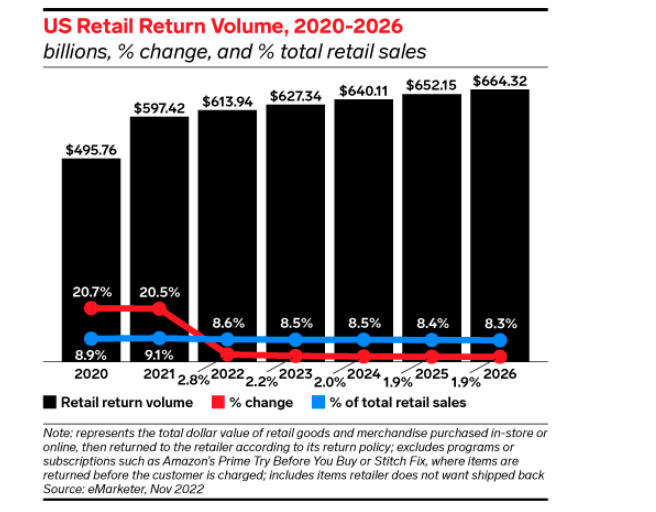Welcome to Parcelconsulting
Welcome to Parcelconsulting

With online product returns becoming an expectation rather than an exception, integrating strategic ecommerce trends and innovative shipping into your returns policies is crucial for staying competitive. Prioritizing customer satisfaction through accommodating return policies can transform potential challenges into opportunities for growth and retention. This importance underscores why your small business’s approach to ecommerce returns and return policies needs not only to meet but outshine competitors’ efforts.
The current e-commerce landscape places significant emphasis on flexible and customer-friendly return policies, as these have become key differentiators for online retailers. With the rise of online shopping, customers expect hassle-free returns and exchanges, which can significantly influence their purchasing decisions and overall satisfaction. Companies are increasingly adopting lenient return policies, offering free returns, extended return windows, and easy-to-use return processes to build trust and loyalty.
These policies often include pre-paid return labels, in-store return options for omnichannel retailers, and instant refunds or exchanges. However, managing returns effectively poses logistical challenges and costs for businesses, necessitating efficient reverse logistics systems. The competitive e-commerce environment makes it crucial for retailers to balance generous return policies with strategies to minimize return rates, such as detailed product descriptions, high-quality images, and customer reviews to ensure that customers make informed purchasing decisions. Overall, a well-crafted return policy is now a vital component of the e-commerce strategy, enhancing customer experience and driving repeat business.

Recent studies reveal that at least 30% of all products ordered online are returned, a stark contrast to the 8.89% return rate in brick-and-mortar stores. This statistic underscores a notable change in consumer behavior and expectations within the digital marketplace.
Consumers are increasingly prioritizing convenient and flexible return policies. An impressive 92% of consumers are more inclined to make a repeat purchase if the return process is simple, while 79% insist on free return shipping. Moreover, the integration of physical and online shopping experiences, such as the ability to return online purchases in-store, has become a significant factor in consumer decisions. shoppers express a preference for online platforms that offer in-store return options, demonstrating the value of seamless, omnichannel service offerings.
A shipping policy is a critical document for any ecommerce business, serving as a clear guide for customers about what to expect when they make an online purchase. This policy usually details crucial information such as shipping costs, methods, and delivery timelines. It’s vital that this policy is not only comprehensive but also clear and easy to understand to prevent any confusion and ensure customer satisfaction.
Common shortcomings in standard shipping policies, such as high shipping costs, slow delivery times, lack of tracking information, and inflexible delivery options, can significantly affect customer perception and satisfaction. Elevated shipping costs can discourage customers from finalizing their purchases, particularly when competitors provide free or discounted shipping options. Slow delivery times and the absence of reliable tracking information create uncertainty and frustration, leading to a negative shopping experience. Inflexible delivery options, such as not offering expedited shipping or specific delivery time windows, further inconvenience customers and diminish their overall satisfaction.
These shortcomings can result in higher cart abandonment rates, reduced customer loyalty, and negative reviews, ultimately impacting a retailer’s reputation and bottom line. To improve customer perception, businesses need to address these issues by offering competitive shipping rates, transparent tracking, faster delivery options, and flexible delivery arrangements that cater to the diverse needs of their customers.
By addressing these common shortcomings and ensuring your shipping policy is detailed and customer-focused, your business can significantly enhance customer satisfaction and perception. Adopting this proactive stance not only fosters trust but also establishes your brand as dependable and customer-oriented within the competitive e-commerce landscape.
Boosting customer experience and reducing support tickets are pivotal in enhancing your return policies. Providing a range of return choices, from full refunds to exchanges, store credit, gift cards, and warranties, not only enhances customer contentment but also cultivates loyalty, a vital component for retail enterprises. Effective return policies strike a balance between customer preferences and business viability by offering transparent, adaptable alternatives, which may incorporate restocking charges or shipping expenses to mitigate the financial implications of returns.
A competitive return policy is one that sets your business apart in the ecommerce landscape. Presenting a myriad of return alternatives enriches customer satisfaction and fosters allegiance by accommodating varied consumer inclinations. The promptness and simplicity of reimbursements play pivotal roles in customers’ decisions on where to conduct their online transactions. Furthermore, e-commerce outlets providing the ability to return items in-store inspire greater confidence in purchase choices, diminish the probability of subsequent returns, and bolster business reputation and revenue expansion through favorable reviews and recurring purchases.
Implementing innovative return policies such as same-day returns can dramatically increase consumer confidence and satisfaction. This practice, although logistically challenging, ensures that customers can resolve return issues swiftly, enhancing their overall shopping experience.
Free shipping upgrades are another strategic approach that can incentivize purchases. By offering expedited shipping at no additional cost, businesses can attract customers who value speed and convenience, potentially increasing sales volumes.
Extended return periods provide customers with ample time to evaluate their purchases, which is especially beneficial for high-involvement products. This adaptability can markedly alleviate purchase apprehension, resulting in elevated conversion rates and strengthened customer allegiance.
No-questions-asked returns simplify the return process by removing potential obstacles for the customer. This approach can lead to increased customer trust and a higher likelihood of repeat purchases, as it assures customers that they can return products without hassle.
By embracing these inventive methodologies, enterprises not only fulfill but surpass customer anticipations, nurturing loyalty and carving out a competitive advantage in the bustling e-commerce arena. These strategies, highlighted through successful case studies, demonstrate the profound impact of customer-focused shipping and return policies on business success.
Deploying and skillfully promoting refreshed shipping and return protocols are pivotal strides for any e-commerce venture seeking to elevate customer contentment and uphold a competitive advantage. This section will delve into the practical steps required to revamp these policies, methods for communicating these changes to customers, and innovative marketing strategies to highlight your superior policies.
Revamping your shipping and return policies involves several key steps to enhance customer satisfaction and operational efficiency. Begin by scrutinizing customer input and return metrics to pinpoint prevalent challenges and opportunities for enhancement. Compare against rivals to grasp industry norms and optimal methodologies. Simplify the return process by offering prepaid return labels, clear instructions, and multiple return options, such as in-store or curbside returns. Update your return window to provide customers with adequate time to make return decisions, while balancing the need to manage inventory effectively.
Above all else, clearly communicate any policy changes across all customer touchpoints, including your website, order confirmations, and customer service interactions. Educate your team to manage returns with efficiency and politeness, guaranteeing a smooth encounter for the customer. Lastly, consistently assess and appraise the efficacy of your revamped protocols, making adaptations as necessary according to ongoing feedback and performance indicators. This comprehensive approach will help build trust, reduce friction, and foster long-term customer loyalty.
Effectively communicating changes to customers regarding return policies requires a clear, proactive, and multi-channel approach to ensure transparency and maintain trust. Begin by notifying customers well in advance through various touchpoints, such as email newsletters, website banners, and social media posts, to ensure wide visibility.
Use concise and straightforward language to explain the specific changes and the reasons behind them, highlighting any benefits or improvements. Incorporate an extensive FAQ segment to tackle frequent queries and offer illustrations of the new policy’s functionality. Additionally, ensure that customer service representatives are well-informed and ready to assist with questions or issues.
Providing a grace period for the transition and reinforcing the message through follow-up communications can further help customers adapt to the new policy. By clearly articulating the changes and demonstrating a commitment to customer satisfaction, businesses can minimize confusion and maintain positive relationships with their customers.

To effectively market your superior return policies, emphasize them in all customer touchpoints to build trust and differentiate your brand. Highlight key aspects of your return policy—such as free returns, extended return windows, and hassle-free processes—in your website’s homepage banners, product pages, and checkout process. Use email marketing to inform existing customers about the benefits and ease of your return policy, reassuring them of a risk-free shopping experience. Harness social media channels to disseminate customer testimonials and triumph narratives illustrating the ease and customer gratification resulting from your return procedures.
Wisely partner with influencers to amplify your message and extend your reach to a wider audience. Additionally, consider creating targeted ads that emphasize the customer-friendly nature of your returns, aiming at converting potential buyers who may be hesitant due to return concerns. By consistently communicating the advantages of your return policy, you can enhance customer confidence, increase conversion rates, and foster long-term loyalty.
Following these steps and effectively communicating the benefits of your updated policies will enable you to significantly enhance customer satisfaction and loyalty. Additionally, innovative marketing strategies will ensure that your superior shipping and return policies stand out in the competitive ecommerce landscape, attracting new customers and retaining existing ones.
Monitoring and adapting your policies is an ongoing process that ensures your ecommerce operations remain competitive and aligned with customer expectations. This involves using a variety of tools and metrics to assess the impact of your shipping and return policies and continuously refining these policies based on customer feedback and competitive analysis.
Implementing new policies requires careful monitoring to gauge their effectiveness. Tools like Google Analytics and SimilarWeb provide crucial data that helps businesses understand visitor behavior, bounce rates, and conversion rates. These observations enable you to juxtapose with competitors and pinpoint avenues for enhancement.
By continuously monitoring these tools and metrics, businesses can make informed decisions that enhance customer satisfaction and improve overall business performance.
Adapting and refining your policies should be a dynamic process influenced by ongoing market analysis and customer feedback. Here are some strategies to ensure your policies remain competitive and customer-centric:
By implementing these tips, your business can not only respond to current customer needs and market conditions but also anticipate future changes, ensuring your shipping and return policies remain a strong competitive advantage in the ecommerce landscape.
The current ecommerce landscape underscores the necessity for small businesses to refine their shipping and return policies to stay competitive. By prioritizing customer satisfaction through transparent, flexible, and customer-friendly policies, businesses can turn potential challenges into opportunities for growth and retention.
Key strategies include evaluating and enhancing current policies, adopting innovative return practices such as same-day returns and free shipping upgrades, and effectively communicating and marketing these improvements. Observing and adjusting these policies in response to customer feedback and competitive analysis is pivotal to uphold their congruence with shifting customer anticipations and market dynamics.
Parcel Consulting is the ideal partner to help revamp your return policy, offering expert guidance and tailored solutions that align with industry best practices and your specific business needs. With a deep understanding of ecommerce logistics and customer behavior, Parcel Consulting can help you design and implement policies that enhance customer satisfaction and loyalty while optimizing operational efficiency.
Our comprehensive approach ensures that your return policies not only meet but exceed customer expectations, positioning your brand as a leader in the competitive ecommerce market. Partnering with Parcel Consulting will enable you to leverage their expertise and innovative strategies to achieve sustainable growth and a stronger customer relationship.
Get Started with Parcel Consulting Today! Contact us now to schedule a consultation and discover how we can help you set up a Virtual Carrier Network that revolutionizes your logistics operations. Visit our website to take the first step towards a more efficient and cost-effective shipping solution.